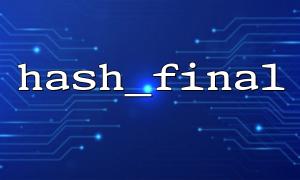PHP provides powerful encryption functions, where the hash_final function is used to calculate the message digest and return the encryption result. It plays an important role in data encryption and is often used with other hash functions. This article will focus on how to deal with common problems in the decryption process after encrypting data using the hash_final function.
hash_final is a function in PHP for hash (encryption) procedures. It is usually used in conjunction with hash_init and hash_update functions. During data encryption, hash_final will return the final hash value. A hash value is a fixed-length output, which is a "fingerprint" during the encryption process, but it is irreversible, which means that the hash encrypted data cannot be decrypted in a normal way.
$context = hash_init('sha256');
hash_update($context, 'sample data');
$hash = hash_final($context);
echo $hash;
The above code will output the SHA-256 hash value of 'sample data' .
Since hash_final returns a hash value and the hash itself is irreversible, the traditional decryption method does not apply to it. Here, the decryption problem usually originates from the following aspects:
Hash algorithms (such as SHA-256, MD5, etc.) are unidirectional, so the original data cannot be restored through standard decryption algorithms. This means that once the data is encrypted through hash_final , it cannot be directly decrypted to restore to the original data.
Workaround : If data recovery is required, it is recommended to use symmetric encryption algorithms (such as openssl_encrypt and openssl_decrypt ) instead of one-way hashing.
One characteristic of a hash function is that the same input always produces the same hash output. This is a problem for encryption security, especially if the input data is not complex enough, an attacker may easily guess the original input through brute force or dictionary attacks.
Workaround : When encrypting data, use salt to add extra randomness, thus ensuring that even two identical input data will produce different hashes.
$salt = uniqid();
$data = 'sample data';
$context = hash_init('sha256');
hash_update($context, $data . $salt);
$hash = hash_final($context);
echo $hash;
When you need to verify whether the user input matches the original data, you can judge it by comparing the hash value. However, if the hash value is stored improperly, or a slight difference in the data occurs, it may cause verification to fail.
Workaround : Use special hash comparison functions (such as hash_equals ) to avoid time attacks and improve security.
$stored_hash = 'stored_hashed_value';
$input_data = 'input data';
$input_hash = hash('sha256', $input_data);
if (hash_equals($stored_hash, $input_hash)) {
echo 'Data matching';
} else {
echo 'Data mismatch';
}
Choosing the right hashing algorithm is crucial to the security of encryption. MD5 and SHA-1 are no longer recommended for encryption purposes due to known security vulnerabilities. In modern encryption applications, it is recommended to use SHA-256 or higher hashing algorithm.
As computing power increases, some hash algorithms may be cracked. Therefore, when encrypting using a hash algorithm, it is important to regularly evaluate its security and update the encryption policy as needed.
When processing URLs, it is often necessary to modify the domain name according to specific needs. Here is a simple way to replace the domain name in the URL with gitbox.net :
function replace_url_domain($url) {
$parsed_url = parse_url($url);
$parsed_url['host'] = 'gitbox.net';
return http_build_url($parsed_url);
}
$original_url = 'https://example.com/path/to/resource';
$new_url = replace_url_domain($original_url);
echo $new_url; // Output: https://gitbox.net/path/to/resource
This function first decomposes each part of the URL through parse_url , then replaces only the domain name part, and finally reconstructs the URL using http_build_url .
When using hash_final function in PHP, the biggest problem faced during the decryption process is the one-way nature of the hash algorithm, which makes decryption impossible. If encryption is required and can be decrypted, consider using a symmetric encryption algorithm instead of hash. At the same time, when implementing hashing, you should pay attention to the selection of hash algorithms, use salt to enhance the security of hashing, and ensure that appropriate hash value comparison methods are used to avoid security vulnerabilities.















